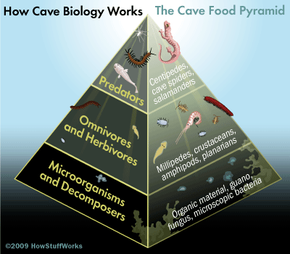The Cave Ecosystem
As you probably learned in biology class, all life depends on sunlight -- a process known as photosynthesis. This is true even for the deepest, darkest part of a cave, otherwise known as the dark zone. We know that no green plants can grow in the dark zone. So how do those troglobites, the organisms that live solely in the dark zone, survive? The answer is simple -- through a food chain, just like everything else on our planet. Let's take a closer look at that chain.
One way for food to get into a cave is through natural weather events like a flood. Excess rainwater washes leaves, twigs and plants into a cave, providing munchies for insects and other animals. Another way that nutrients enter a cave is simply when animals -- trogloxenes and troglophiles -- bring it in.
Advertisement
Yet another food source for cave organisms is one you probably haven't thought about -- guano. Guano is full of organic matter, and troglobites love to feed on this stuff. What is guano? It's the scientific term for bat poop. Bats nest deep inside the cave, and their droppings will pile up several feet high and several feet wide. Very few animals can feed directly on these droppings, but bacteria and fungi found in the cave can decompose guano into basic food and nutrients.
As you can see, all the different organisms in a cave depend on each other for survival. We call this a food chain and here's how it works, starting at the bottom:
Organic material, such as guano, other animal droppings and washed-in plants provide a haven for fungus and microscopic bacteria, which feed on the organic material, breaking it down into simple nutrients. Then, millipedes and tiny crustaceans feed on the fungus, bacteria and the nutrients left behind. Bigger insects, such as cave beetles, feed on these millipedes, crustaceans and even the eggs of cave crickets. Centipedes, cave spiders, salamanders and cavefish feed on insects smaller than them. Some cave centipedes grow so large, they've been spotted feasting on bats [source: Krajick].
Because there are more animals and organisms at the bottom of the cave food chain than at the top, it might be better to call it the cave food pyramid. You'll find many decomposers at the base of the pyramid, with the more evolved carnivores at the top.
On the next page, we'll discuss the science of studying cave life and the challenges of working in the dark zone.
